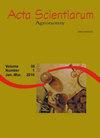Biochemical responses to chilling injury in sweet potato after cold storage
IF 1.2
4区 农林科学
Q3 AGRONOMY
引用次数: 0
Abstract
This study examined biochemical changes associated with chilling injury (CI) in sweet potato roots stored at low temperatures and reconditioned at ambient temperature. Sweet potato cultivars BRS Amélia and BRS Rubissol were stored at 6 or 13°C for 4 days at ambient temperature (“ambient reconditioning”: 21 ± 2°C). CI on the outer surface of the roots occurred earlier in BRS Amélia than in BRS Rubissol. The CI index on the inner surface of the BRS Amélia was higher when it was stored at 6°C for 40 + 4 days. BRS Amélia showed higher proline content and electrolyte leakage when stored at 6°C. Ascorbate peroxidase was induced by storage at 6°C for 30 + 4 days in BRS Amélia and from 40 + 4 days in BRS Rubissol. The malondialdehyde and phenolic compounds of BRS Rubissol increased during storage at 6°C. CI in both cultivars was associated with increased peroxidase and polyphenol oxidase activities. Storage of sweet potato cultivars at 6°C for 50 + 4 days caused severe damage to the roots. Cultivars BRS Amélia and BRS Rubissol showed similar symptoms of CI and can be characterized as being sensitive to low temperatures.甘薯冷藏后对冷害的生化反应
本研究研究了低温储存和常温修复甘薯根系与冻害相关的生化变化。甘薯品种BRS am和BRS Rubissol分别在6°C和13°C环境温度下保存4天(“环境修复”:21±2°C)。青霉霉根外表面CI的发生早于青霉霉。在6℃条件下保存40 + 4天,BRS am内表面CI指数较高。BRS amsamlia在6°C保存时脯氨酸含量较高,电解质泄漏。抗坏血酸过氧化物酶分别在BRS am和BRS Rubissol中分别于6°C和40 + 4天培养。在6°C贮藏期间,红豆醇的丙二醛和酚类化合物含量增加。两个品种的CI均与过氧化物酶和多酚氧化酶活性增加有关。甘薯品种在6℃条件下贮藏50 + 4天,对根系造成严重损害。品种BRS am和BRS Rubissol表现出相似的CI症状,并且对低温敏感。
本文章由计算机程序翻译,如有差异,请以英文原文为准。
求助全文
约1分钟内获得全文
求助全文
来源期刊

Acta Scientiarum. Agronomy.
Agricultural and Biological Sciences-Agronomy and Crop Science
CiteScore
2.40
自引率
0.00%
发文量
45
审稿时长
>12 weeks
期刊介绍:
The journal publishes original articles in all areas of Agronomy, including soil sciences, agricultural entomology, soil fertility and manuring, soil physics, physiology of cultivated plants, phytopathology, phyto-health, phytotechny, genesis, morphology and soil classification, management and conservation of soil, integrated management of plant pests, vegetal improvement, agricultural microbiology, agricultural parasitology, production and processing of seeds.
 求助内容:
求助内容: 应助结果提醒方式:
应助结果提醒方式:


